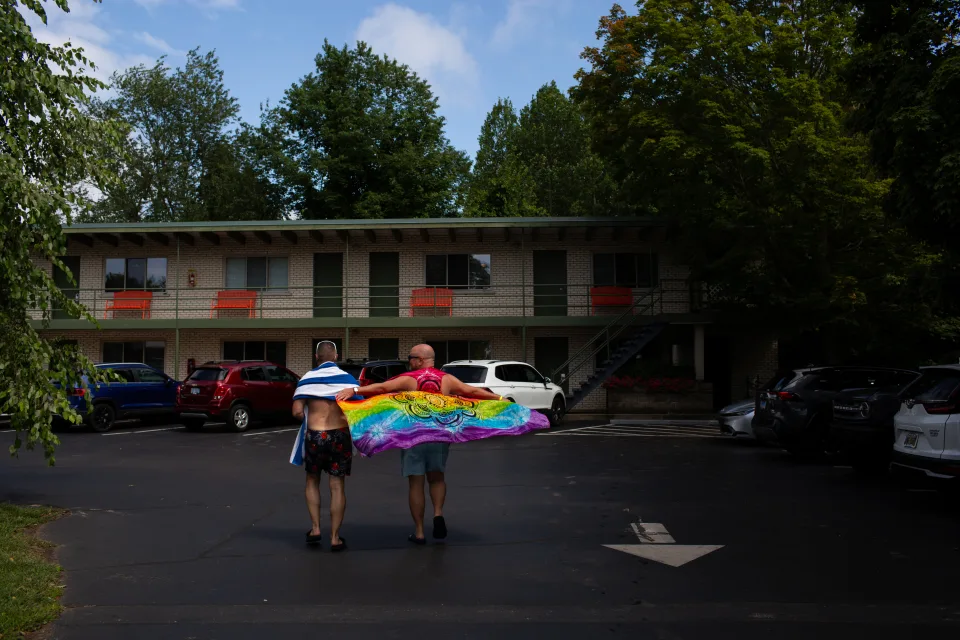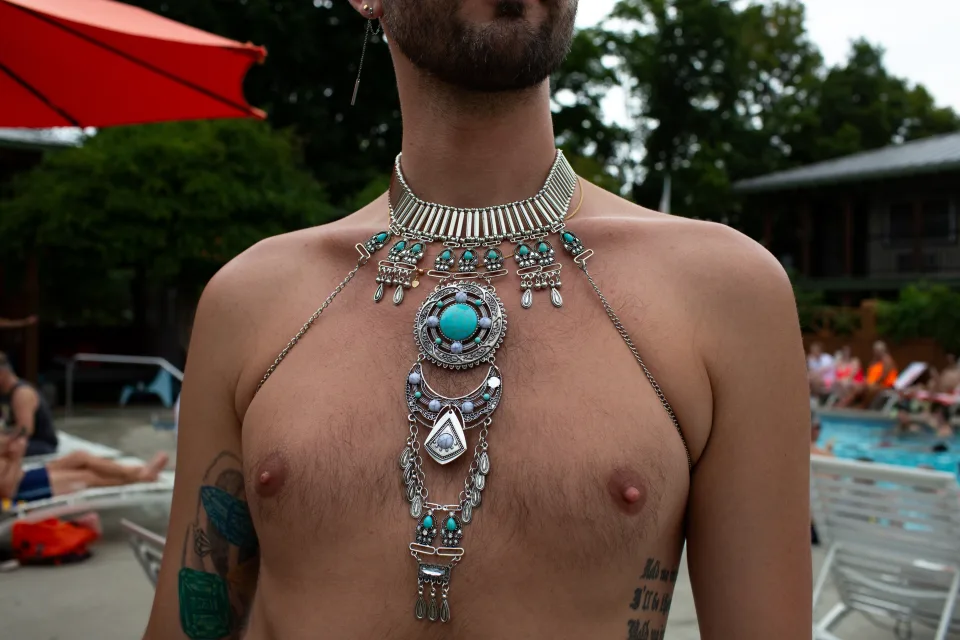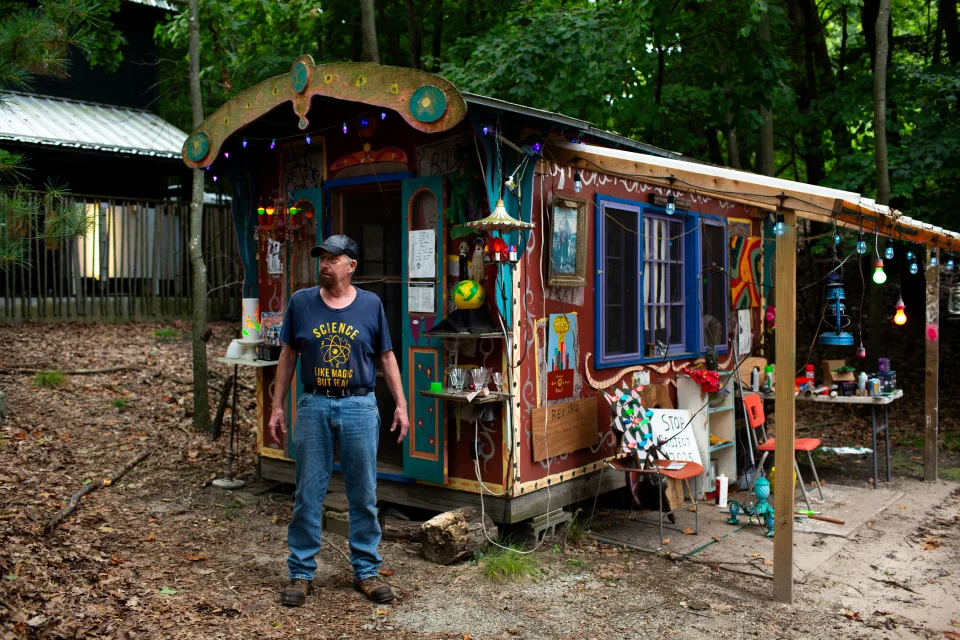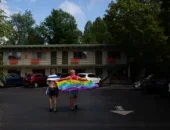Gay artists, club owners and nude bathers have found a safe haven in Saugatuck and Douglas since the 1890s.
By Julia Carmel August 24, 2024 at 8:00 Reprinted from The Washington Post

In the summers, West celebrates with friends on the lake. During winter, he’s part of a gay bowling team called the Gutter Queens. Since relocating in 2021, he’s become a real estate agent, spending his days selling other people on the joys of life here.
 Saugatuck and its neighboring town, Douglas, form a rainbow bubble within Michigan’s Bible Belt. The area is off the beaten path compared to the coastal hangs that typically attract huge gay crowds, yet its reputation rivals spots like Provincetown and Fire Island.
Saugatuck and its neighboring town, Douglas, form a rainbow bubble within Michigan’s Bible Belt. The area is off the beaten path compared to the coastal hangs that typically attract huge gay crowds, yet its reputation rivals spots like Provincetown and Fire Island.
Pride flags fly from many businesses and homes, a stark difference from the conservative towns in Western Michigan. At the Dunes Resort, the pool is packed with Speedo-clad gay men all summer long, and disco balls light up the confetti-filled dance floor every weekend.
“This is a small community where we get to enjoy the finer things in life and be comfortable and free,” West said. “It’s paradise for somebody like me to be able to come to a place and just feel so welcome.”
There’s evidence of queer tourists and residents flocking here since the late 19th century, thanks to a long and colorful cast of eclectic artists, eccentric couples and LGBTQ+ entrepreneurs.
 Gay travel guides like Bob Damron’s Address Book began ramping up around the same time, dubbing Saugatuck “The Fire Island of the Midwest.” Though a state law prohibited bars from hosting groups of gay people, a local jazz venue called The Blue Tempo became known for serving gay patrons.
Gay travel guides like Bob Damron’s Address Book began ramping up around the same time, dubbing Saugatuck “The Fire Island of the Midwest.” Though a state law prohibited bars from hosting groups of gay people, a local jazz venue called The Blue Tempo became known for serving gay patrons.
“They collected $5 to use their beach for the day,” said John Rossi, the facilities manager for Ox-BowSchool of Art and Artists’ Residency, a program that’s affiliated with the School of the Art Institute of Chicago. “You could sunbathe nude, as long as you were not visible to the public.”
Rossi visited Denison’s Beach, owned by a local marine businessman named Frank Denison, for the first time in the 1970s. “It was mostly gay, but there was a mix, I could tell,” Rossi said. “Sometimes there were lesbians that frequented it, and occasionally you might see a straight couple.”
 Rossi, 68, grew up about 40 miles away in Grand Rapids. He said word-of-mouth recommendations initially brought him to the area. “There was this network — people told you, you knew what was safe and what wasn’t,” Rossi said. “I mean, there were three bars in Grand Rapids. There were two bars in Lansing you could go to. There were a lot of bars in Detroit we used to go to.”
Rossi, 68, grew up about 40 miles away in Grand Rapids. He said word-of-mouth recommendations initially brought him to the area. “There was this network — people told you, you knew what was safe and what wasn’t,” Rossi said. “I mean, there were three bars in Grand Rapids. There were two bars in Lansing you could go to. There were a lot of bars in Detroit we used to go to.”
The Blue Tempo burned down in 1976, and the loss of that de facto gay space was felt immediately. By the early 1980s, Jennings had come out to his family and found his life partner, Larry Gammons. The couple decided to go into business together.
“We thought, ‘You know what, we should open a gay resort,’” said Gammons, who is now 77.
They originally set their sights on a hotel in Saugatuck, but the town council didn’t want to issue a liquor license to a gay business. After they were turned down for a third time, they found a shuttered roadside motel in Douglas and quickly made an offer on the property. At the first Douglas council meeting, they were able to secure their liquor license.
 Nonetheless, the resort was popular and quickly earned a reputation for throwing huge parties with fantastic entertainment.
Nonetheless, the resort was popular and quickly earned a reputation for throwing huge parties with fantastic entertainment.
They booked performers such as Eartha Kitt, Linda Clifford and The Weather Girls and hosted tea dances every Sunday. “We turned down Madonna,” Gammons said. “Her brother lived in the Detroit area, and he was gay, and Carl was DJing. She was just a punk rocker, and she went up to [Carl] when he took a little break and said, ‘I’m better than that girl. You know, you ought to put me onstage.’”
“We turned her down, and it was about six, eight months after that, she went to New York and got discovered,” he added.
The parties raged on for decades, with Gammons telling The Chicago Tribune in 1995 that gay tourism was bringing “an estimated $6 million annually to the area.” Gammons and Jennings sold The Douglas Dunes in 1998 to Danny Esterline, Greg Trzybinski and Mike Jones, who renamed it The Dunes Resort.
Though there is a widely cited statistic about Saugatuck-Douglas being home to more than 140 gay-owned and gay-friendly businesses, Jones said in an email that number was “made-up” for press releases and websites to “promote the area as gay-friendly.”
“It really stood out as like, ‘this isn’t normal.’ Even in Chicago in the late 90s, guys weren’t holding hands walking downtown,” he said. “And you’re really right in the middle of God’s Christian reform, Southwest Michigan. So it’s almost like there’s a bubble over us. You have to remember that the whole world isn’t like this.”
Though Jones had visited many of the popular gay hot spots and swore he’d never live in a small town, he felt differently at the Dunes.
“I’ve been to P-town, and we’ve been to Fire Island, and we’ve been to Key West, and Rehoboth, but they’re just a different attitude,” Jones said. “And I never thought when I was in Fire Island or P-town or Rehoboth, ‘This place is great. I want to live here.’”
With a bit of close reading, the queer history in Saugatuck and Douglas dates back more than 120 years. Gollannek, the director of the local history center, said there are examples of same-sex relationships from the late 1800s through the 1920s.
Some gay tourism can be attributed to the rise of steamboat travel, which made it easier for visitors to make their way over from Chicago. But the most obvious influence on the area’s emerging queerness was a woman named Elizabeth Bandle.
“She and her family had land in Saugatuck on a farm,” said Shanley Poole, 27, the engagement liaison and storyteller for Ox-Bow. “She invited a few students and professors up to do plein-air painting, because the lighting there was just gorgeous, and it kind of became a tradition year after year.”
 Among the people who visited Bandle Farm in the early 1900s were Frederick Fursman and Walter Marshall Clute, artists from the School of the Art Institute of Chicago who went on to found Ox-Bow in 1910. Since artists and city-dwellers were typically more accepting of queer people at the time, it created an environment that fostered gay tourism.
Among the people who visited Bandle Farm in the early 1900s were Frederick Fursman and Walter Marshall Clute, artists from the School of the Art Institute of Chicago who went on to found Ox-Bow in 1910. Since artists and city-dwellers were typically more accepting of queer people at the time, it created an environment that fostered gay tourism.
“In 1910, we have these groups of artists and free thinking individuals — bohemian folk — coming to a secluded area,” Gollannek said. “Avant-garde artists coming here, painting plein-air, working with nude models, and this becomes a place where there’s some openness.”
The Saugatuck-Douglas History Center has records of LGBTQ+ people living in the area starting in 1917, with interior designer Florence “Dannie” Ely Hunn purchasing a cottage near Saugatuck-Douglas with Mabel “Jims” Warren, her partner of more than 50 years.

